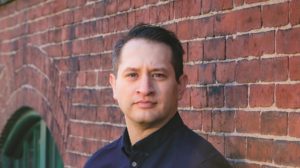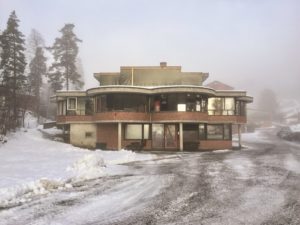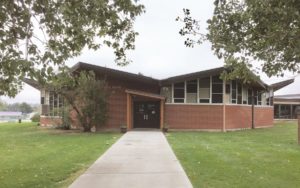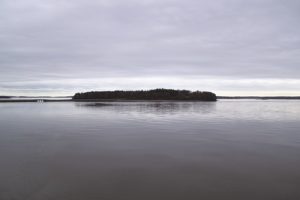When Jeffrey Yasuo Mansfield was eight years old, he “lost” his hearing aids — much to the chagrin of his parents. “They constantly buzzed whenever the batteries ran low,” he said in a recent email, “and while hearing aids can be valuable for many, I was only getting marginal benefits from them.”

For those who do use hearing aids or cochlear implants, buildings — with their heating, ventilation, and air conditioning systems — can be clamorous places. “I think, in our everyday lives, it’s often easy to forget that, beyond an aural phenomenon, sound is a physical phenomenon and travels differently through different materials and surfaces,” Mansfield wrote.
The way sound travels is one of many things that Mansfield takes into account when designing and studying deaf spaces. Circular layouts, ample space, and natural lighting also help deaf people communicate with one another through sign language.
Mansfield, who is a resident at Twenty Summers’ Hawthorne Barn this week along with poet Raymond Antrobus, has been deaf from birth. He grew up in Arlington and attended the Learning Center for the Deaf in Framingham. There, he learned American Sign Language and English. “From preschool to high school,” he wrote, “I grew up in a language-rich environment where my Deafness was not a challenge but a proud cultural identity.”
Mansfield capitalizes “Deaf” when referring to the culture or to a group of people. He corresponded with the Independent via email, rather than via Zoom with an interpreter, to ensure accuracy: American Sign Language, like any other language, is subject to mistranslation.

When Mansfield transitioned to a mainstream environment after the Learning Center, he wrote, “I began to sense a profound disconnect between social attitudes towards Deafness as a deficiency — and the vibrant community that thrived amongst my peers at the school.”
It is exactly this disconnect that Mansfield tries to address in his research. The design director at MASS Design Group, Mansfield holds a master’s degree from the Harvard Graduate School of Design and has received grants and fellowships from the Graham Foundation, Library of Congress, Ford Foundation, and Andrew W. Mellon Foundation.
Mansfield is also a fourth-generation Japanese American. He sees parallels here: “For many communities, such as the Deaf community or the Japanese American community, who have been deeply impacted by our built environment, connecting cultural memory and identity into the design process is incredibly meaningful as an act of resistance, healing, and hope.”
He believes that educational institutions in general are too much like prisons, and that it’s especially true of schools for the deaf. Historically, many of them were designed by the same architects responsible for prisons, hospitals, and asylums.

“I once encountered a dormitory that was a direct facsimile of a 1970s prison blueprint,” he wrote, “with a separate staff entryway, observation booths, and an over-scaled ‘dayroom’ surrounded by barbed wire fencing.”
Mansfield’s research reveals the relationship between “the body, education, and the state” and “the ways in which we understand our bodies and privilege certain bodies at the expense of others,” he wrote.
There are, however, plenty of examples of buildings that are well designed for the deaf community. The Skådalen Døveskole in Oslo, for example, designed by Norwegian architect Sverre Fehn in 1975, is built into a hillside, and includes “multi-level sightlines” and “circular and semi-circular geometries,” and is “scaled to the height of the child.” Another example was the Wyoming School for the Deaf, which unfortunately closed in 2000, but which had large windows and skylights as well as pentagonal classrooms.
“When you and another Deaf person share a space but are preoccupied in something or not looking directly at each other, and you want to get their attention, yelling at a high pitch or waving your arms might not always work,” explained Mansfield. The architect of the Wyoming School for the Deaf, who had two deaf children, developed a solution. “He specified a system of hollow core wooden floors, similar to the floors we might see in a dance studio, so that you could stomp your feet on the ground and vibrations would travel through the floor, drawing the attention of the Deaf person otherwise engrossed in a book across the room.”

Mansfield said that universal design — that is, making spaces accessible to everyone — is an important principle for architects. But he added, “In a world that values efficiency, there are potential pitfalls, such as the standardization of replicable, one-size-fits-all solutions at the expense of contextual solutions.”
Another challenge is balancing honoring the uniqueness of deaf culture without isolating or othering it. The Governor Baxter School for the Deaf, for example, is located on Mackworth Island, just off the coast of Falmouth, Maine. Its location shows how deaf and disabled people have been pushed to the margins of society, said Mansfield. “But every time I visit this island,” he wrote, “set in the picturesque beauty of its towering conifers and rocky shoals, the island also conjures a more productive analogy: It is a sanctuary.”
Intelligent Design
The event: “Spaces of Reconnecting: Of Deafness, Internment, and Pandemic,” a Zoom talk with Jeffrey Yasuo Mansfield
The time: Saturday, May 22, 1 to 2 p.m.
The place: Register at 20summers.org
The cost: Free



